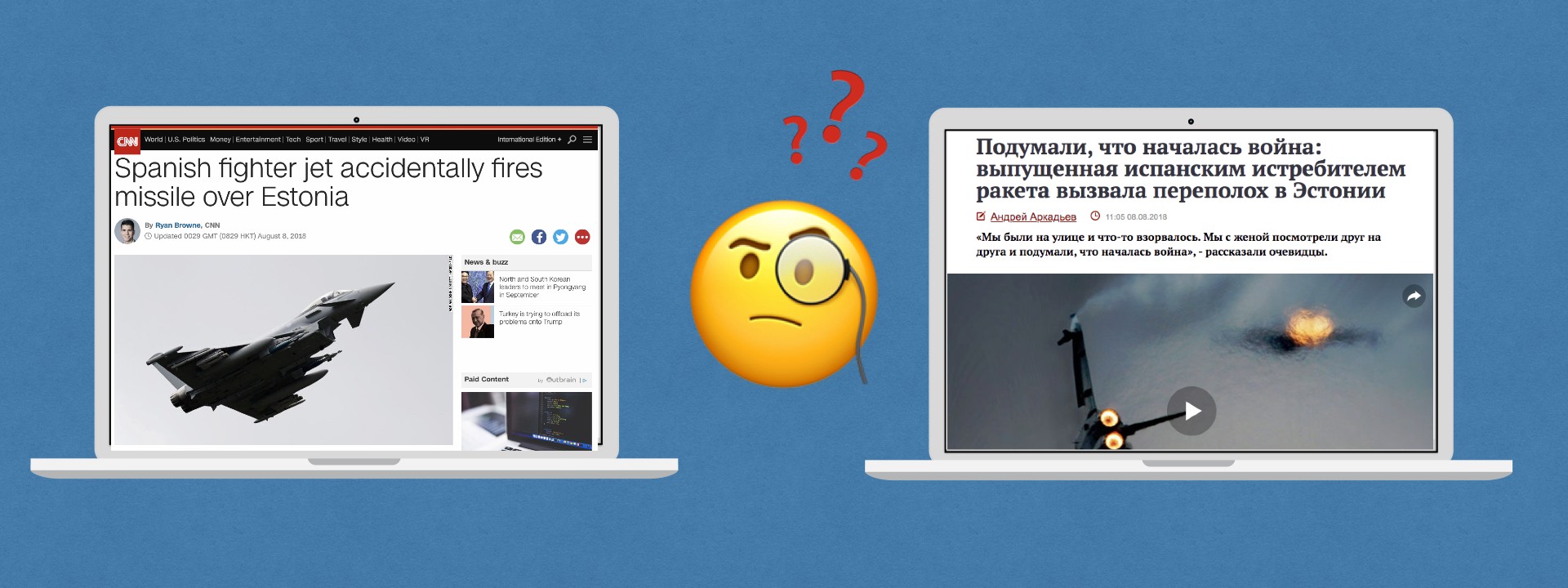#BalticBrief: Accidental Missile Launched Over Estonia
Russian media spun the story about a NATO fighter jet in Estonia
#BalticBrief: Accidental Missile Launched Over Estonia

Russian media spun the story about a NATO fighter jet in Estonia

A Spanish Eurofighter EF2000 jet accidentally fired an AIM-120 Advanced Medium-Range Air-to-Air Missile (AMRAAM) during a training mission in Estonia last week. The accident took place on August 7, 2018, over the village of Pangodi in Tartu County.
Although the missile did not cause any damage and was designed to self-destruct, Kremlin-funded and other pro-Kremlin media outlets exploited the incident to portray NATO negatively. Although Estonian authorities have not found the missile yet, evidence of a potential point of impact was visible in satellite imagery.
Open source analysis also helped to shed more light on the Russian narratives and their effectiveness on this incident.
The Incident
On the day of the incident, Eesti Rahvusringhääling (ERR) — Estonian Public Broadcasting media outlet wrote that a Eurofighter Typhoon of the Spanish Air Force accidentally launched an air-to-air missile at 15.44 EEST while flying on NATO Baltic air policing duty. Reportedly the missile was launched in the northwestern direction, while the plane was flying over Pangodi at an altitude of around 6,000 meters. Though the AMRAAM has a built-in self-destruction system, according to the ERR it couldn’t be ruled out that it failed to explode.
On August 9, ERR reported that the missile sparked a fire in a bog in Jõgeva County. According to ERR, a bog caught fire in the search area, and rescuers began to extinguish it in the evening of the incident. Due to the fire being deep in the turf, rescuers were still extinguishing the fire on August 9. No follow-up reporting was published on the bog fire afterwards.
Reports did not report the exact location of the fire either. The satellite imagery analysis of the Jõgeva County did not provide concrete proof of the reported bog fire. Nonetheless, in the swampy area of Endla jarv a foggy pattern resembling a smoke trail appeared on August 10. The resolution of the image was too low to verify that this was the location of the fire, nonetheless the pattern was similar to a smoke pattern and the location and time frame fit the description presented in the ERR reports.

The signs of potential smoke trail were not visible in the satellite imagery taken after August 10, which suggested that the fire might have been put out. On August 10, ERR reported that the missile debris was not yet found, the report did not mention the status of the fire extinguishing in the bog.
As the exact location of the missile remains unknown, the reports mentioned Endla area as the most likely location. This nature reserve is located approximately 67 kilometers from the nearest point of Estonian-Russian border.

Russian Versus Western Narratives
This incident received wide attention from various media outlets in both English and Russian languages. The social listening tool Buzzsumo helped to analyze these trends more in depth using the keywords ‘missile Estonia’ and ‘ракета Эстонии’.
In the period of August 7–14, Buzzsumo Content Analysis tool suggested that there was more English language content than Russian (182 and 48 respectively). Also, the total number of English language content engagements was almost three times higher (3074 and 23125 engagements). The chronological graph suggested that the main outputs in Russian language appeared on August 8, a day later than in English language, which already appeared on August 7.

Buzzsumo Content Analysis also provided a list of the ten most engaged with pieces of content in both languages. As in the previous graph, the English language content dominated the public digital space, with the Kremlin-funded media outlet RT being only the last entry on the list.

Even though pro-Kremlin media received underwhelming online engagement, these articles presented the event in a largely different tone from the English language artciles. Some of the Russian media articles included ironic titles, including the most engaged with TVZvezda.ru article: “They thought that the war has started: a missile launched by a Spanish fighter caused a stir in Estonia.”
Meanwhile the most engaged with article in English language was published by the CNN: “Spanish fighter jet accidentally fires missile over Estonia.” This article provided factual information about the incident without using irony or implying NATO’s incompetence. Russian-language media covered the story from a variety of angles. Some of the articles attempted to portray the Baltic states as NATO’s training grounds and depicted NATO as an occupying force.

A similar tone was set by the Russian Ministry of Foreign Affair’s (MoD) tweet, which said that the incident in Estonia proved that NATO not only cannot protect its allies, but is posing a risk to them instead.
Мы же говорили, что военный блок #НАТО – бесполезный. #МИДзнал pic.twitter.com/OkOzGwI37X
— МИД России 🇷🇺 (@MID_RF) August 8, 2018
The missile likely impacted in a safe distance from the Russian border. It also traveled in the direction opposite of the Russian mainland, which discounted the narrative of a potential attack against Russia.
Conclusion
The accidental missile launch in Estonia allowed for Kremlin-funded media to exploit the incident to promote their narrative.
Despite exact location of the missile being unknown, the location of the bog fire suggested that it landed in a safe distance from the Russian border. Even though the digital information environment was more dominated by the English speaking Western media outlets, Russian media successfully presented alternative version with ironic titles, using the incident to demean NATO. Luckily, the missile did not reach the territory of the Russian Federation, as such incident would have given Kremlin means to respond with more provoking measures.
Follow along for more in-depth analysis from our #DigitalSherlocks.

